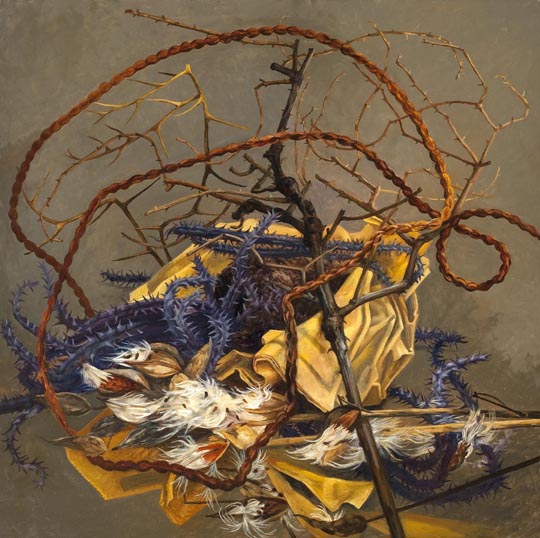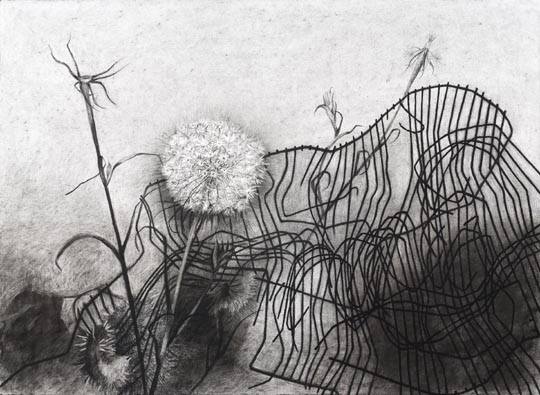"Nature and paint"
By Edith Newhall
For The Philadelphia Inquirer
April 4, 2010

Joan Wadleigh Curran has always drawn beautifully; now her paintings are catching up.
In Curran's latest one-person exhibition at Seraphin Gallery, her paintings are less tentative than they used to be, and her color, previously forlorn, has become warmer and bolder. Her images of nature living within urban decay now seem almost celebratory.
Several of Curran's new paintings also depict recognizable scenes, rather than glimpses of man-made object and nature circling each other in a metaphoric standoff. This time around, nature, previously shown pushing for dominion, seems to have the upper hand. Rehabilitation - Juniata's Garden is not the carefully composed picture Curran used to make; in it, various cacti and succulents create their own imperfect, extravagant composition. The only man-made objects - an orange plastic milk crate, a hose, and some stacks of pots - are relegated to the ground and background of this scene. Two large paintings of fenced areas, Protection (2010) and Trapped (2007), show no nature to speak of, only the failure of the man-made barrier.
Debris (2009), one of the few paintings here that does not depict a scene, is a still life of milkweed pods, sticks, and cactus branches encircled by a rope that recalls Northern European vanitas paintings of the 16th and 17th centuries.
Curran's charcoal drawings and gouache paintings on paper are as exquisitely delicate as ever.
___________________________________________________________________________________________________________
Joan Wadleigh Curran
The Courtauld Institute of Art

Joan Wadleigh Curran’s charcoal drawings explore the intersection of urban and natural materials. Man’s effect on the environment is investigated through the meticulous study of typically overlooked spaces such as scrap yards, construction sites and unkempt street corners. Her works have thus been described as still lifes of the forlorn and neglected.
Human beings are never actually present but their touch is implied through the detritus of the synthetic. Iron bars, barbed wire, fencing and bricks are locked in a series of unusual embraces with the natural. We are left to contemplate life’s great processes, death, decay and regeneration.
Curran’s practice is located halfway between observation and formal concerns. Through her compositions, tension is achieved by the constraint, restriction and subjugation of one material over another. Her work may well be interpreted as a subversion of the botanical study, its fusion with formalist concerns. The latter allows Curran to explore textural effects and the patterns of light and dark, infusing her observations with the universally felt childlike wonder of the world’s complexity.
These formal elements allow Curran to draw out a complex array of emotions. Her work should not be understood as reinforcing the conventional conflict between man and nature. Her compositions are invariably more complex. A discarded fabric or plastic bag can elicit as much sympathy as a pollarded tree. Our expectations are never entirely fulfilled.
Hung alongside our Cabinet of Curiosities, Curran’s work critiques humanity’s categorization of the natural world into neat, manageable components. Are such categories appropriate for aesthetic contemplation? Do they enforce limitations on our cogitative abilities? And finally, could this method of display be understood as man’s arrogant attempt to objectify the natural world?
Tiernan Morgan
Chair East Wing IX
Seraphin Gallery l Contemporary Philadelphia Art Gallery and Art Consultant
1108 Pine St. l 215-923-7000 l seraphin@seraphingallery.com

